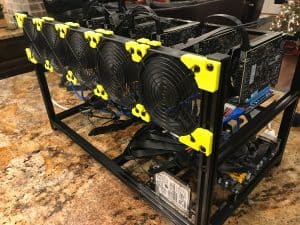Most orders for IN STOCK items placed by 12PM CST M-F ship SAME DAY. Orders for custom items and prints may take additional time to process.
PCIe risers are a staple of the mining community and there some really good reasons to use them. But you most certainly wouldn’t want to use risers for a normal PC or gaming rig! Let’s dive in!

When mining cryptocurrency on a PC 99% of the work is performed by graphics cards (the GPU), rather than on your typical processor (the CPU). The CPU is a general purpose processor. It can do a lot of different things. Generally a CPU has between two and eight general purpose computing cores. This would be something you would see on your standard Intel Core i7 processor. A GPU on the other hand has thousands of cores, but they are very specialized. They are designed specifically for doing math problems, but not much else (at least comparatively. Because of this, GPUs are much better at mining which is nothing more than computing complex math equations.
The modern PC is generally designed with one or two X16 PCIe slots, and several PCIe X1 slots. When running complex graphical simulations or playing modern video games there is a need to move lots of data quickly between the main system’s bus and the GPU. For this situation, an X16 slot is the desired configuration as it has 16 lanes to move data on.
Mining on the other hand simply hands math problems off to the GPU and awaits an answer. Because of this there isn’t a big demand for data transfer between the system bus and the GPU.
Most GPUs are at least double-wide cards. This means that installing a GPU into a PCIe slot also blocks the PCIe slot next to it, even though nothing is plugged into that slot. The space becomes unusable and wasted. So even if every slot on the motherboard was an X16 slot, half of them would be wasted.
GPUs get very hot when used for mining. The cores are basically at 100% utilization 24/7/365. Crowding all of these cards within a 1/4 inch of each other is going to make for a really difficult time keeping the GPUs cool.
PCIe risers solve all of these problems and make it possible to affordably install six or more GPUs into a single platform.
PCIe risers come in two components. The PCIe X1 USB adapter, and the PCIe X16 GPU adapter. The X1 USB adapters plug into each PCIe slot on the motherboard (regardless of whether it is an X1 or X16 slot). Each adapter provides a USB2 or USB3 (depending on brand) connection to run to the X16 GPU adapter. This in effect translates the GPUs X16 slot to an X1 slot allowing everything to work as the manufacturer originally designed, albeit at a slower speed. A slower speed which is plenty fast enough for mining purposes.
The PCIe risers move the GPUs away from the motherboard allowing them to be spaced apart. This allows the slotting of 6 GPUs in a 6 slot motherboard without wasting every other slot.
Similarly, since the cards are no longer dependent on the spacing of the motherboard PCIe slots, PCIe risers allow for the GPUs to be spaced further apart for optimal cooling.
So now you can see that PCIe riser cards are an almost perfect solution for mining rigs. It allows optimal use of existing hardware, and allows the GPUs to be cooled easily. One additional benefit of this design is that fans can spin at slower speeds allowing for an overall quieter mining rig. PCIe risers to require some extra power connections from the power supply (or motherboard if you purchased a mining motherboard such as the Biostar TB250-BTC), so make sure you plan accordingly and get a modular power supply for your mining rig.
My favorite risers are the Victony PCIe risers. They seem to be very reliable and just work.
If you like our content maybe consider upgrading to Premium. You’ll get access to
5 Responses
This has been boggling my mind ever since I saw your mining tour!! Thanks for this.
5
What is the deciding factor for using multiple graphic cards. 1) CPU, 2) Motherboard, 3)Mining app software?
The motherboard input capacity in pcie 1x slots. The above description has so many because the use of a 1x to 16x adapters.
My understanding is that while these use USB cables (and a very non-standard and non-compliant USB A-A type), they are not at all “USB” other than the physical connectors.
I think they just used USB cables as they were a cheap and readily available cable and connector that provides several shielded, balanced transmission lines.